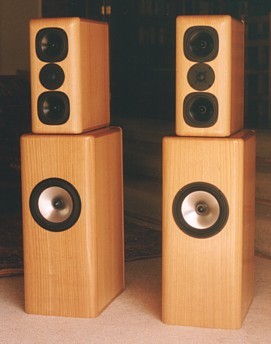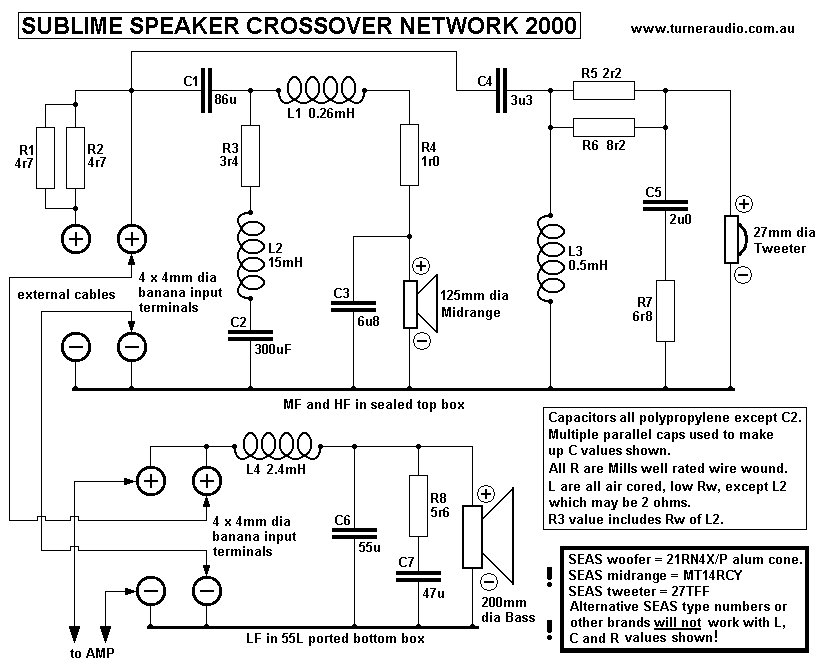LOUDSPEAKERS 1.
Edited 2017.
In 2000, I made a few pairs of loudspeakers which were very well
reviewed by the main local hi-fi
shop in Canberra at that time, Durarone Hi-Fi. Unfortunately,
Duratone's desire for 50% of the retail
price placed my speakers at the same price as European made
imports which had been widely
advertised in the hi-fi press. The models sold at Duratone and
other hi-fi stores are rarely the high
priced elaborate models which were used by imported brands to gain
their reputation favourable press
reviews. So the hi-fi shops mainly sell low grade speakers with a
lauded brand name.
The buying public is fooled into thinking they are buying good
speakers. In a shop, many buyers
become entirely irrational, and often cannot tell any difference
between brands of CD players, amps
or speakers, and often a wife disagrees with all her husband's
buying behavior.
The buying public do not like to buy anything that is not a well
known brand even though the hand made
product can offer far better performance.
I did not make any new loudspeakers since 2001 due to lack of
demand, and fickle buying behavior and
due to shops wanting 50% commission at least.
But the speakers I did make are much treasured by their owners,
and they deserve a mention at this
website which is primarily devoted to good quality hi-fi. There
were two models which I made and offered
in 2000, Sublime and Supreme.
Both sets have two separate enclosures with smaller
midrange-treble unit placed on top of the larger bottom
bass unit.
Sublime.

Supreme.

The enclosures have 38mm thick top and sides made from 3 layers of
plywood. There are two layers of 16mm
and 17mm structural plywood with an outer layer of 4.5 mm of
veneered plywood for appearance.
The resulting asymmetrical panel density tends to reduce
resonances. There is a large amount of well placed
internal braces to prevent movement of the enclosure walls and to
interrupt internal standing waves.
The front and rear baffles are real timber hardwood planks of
Victorian Ash, 42mm thick on the front and
33mm on the rear. The front baffles are fixed to the side and
top/bottoms by many screws and internal hidden
slotted aluminium angles so that no fixing is visible from the
outside, but the screw fixing does allow the real
timber to expand and contract. The front baffles and rear panels
have foam sealing gaskets to ensure air tight
contact but to also provide a soft join between the panels and the
sides and top of the enclosures, allowing
the small amount of natural timber expansion and contraction and
to give added reduced acoustic coupling
in the enclosure itself.
The enclosures have narrow front panels and well rounded corners
to minimize diffraction and optimize
stereo imaging. The the sound from the rear of the bass and
mid-range cones is absorbed by high density
polyester wool which is used in acoustic sound proofing where a
high level of attenuation is needed.
The bass units and mid/treble units have been built as separate
enclosures to prevent mid-range sound from
vibrating the larger bass enclosure woodwork. There is a layer of
felt on the bottom of the mid/treble units,
and because of the weight of the units, ( 85kg for Sublime, ) they
have plenty of inertia to prevent box movement
and there is no need for floor spikes or other point contact
supports to improve the sound.
I made the speakers at a time when I was willing and capable of
fine woodwork after a previous career of 30
years in the building construction industry where I worked as a
carpenter and joiner while supervising others
around me.
To obtain excellent sound, enclosures should have thick walls, be
well braced and baffled internally, and thus
be very heavy. The appearance due to the fine timber grain finish
is completely unnecessary to enhance the sound.
The enclosures will work excellently if made from any stable panel
material of 40mm thickness, and may be
screwed and well glued at corners. It is easy to round off the
external corners, fill all screw holes, sand down all
surfaces, and apply any paint one wishes to use.
The loudspeaker market is supported by very fickle buyers relying
on reviews and virtual slave labor to do the
dirty work in assembly line factories so that huge profits
are possible. Profits and fickleness do not improve
sound quality.
So for those wanting to avoid costs and get good sound, a painted
finish over roughly made enclosures will work
perfectly. The bass units are 55Litre ported reflex with a box
frequency below 35Hz and hence all frequencies
above 40Hz are delivered by the front of the bass cone without the
ill-effects of resonances which occur in
enclosures which are too small so that the enclosure resonance Fb
is too high. Such small enclosures lead to
better company profits and low manufacturing costs but the hi-fi
listener is robbed of good sounding bass !
The bass from my 55L units extends to 22Hz. No sub-woofer is
needed, and the bass sounds well integrated
and fast without the tendency of sloppy bass and woolliness
that sub-woofers so often generate.
The mid-range and treble enclosure is a sealed box, and crossover
F are at 300Hz and 3kHz.
All the speaker drivers are SEAS units because I liked their
accuracy, lack of coloration, low distortions,
smooth response within their bandwidth, lack of cone break-up
behavior, and their ease of use since relatively
simple crossover filters were required.
Bass drivers were SEAS
L21RNX/P
Mid-range drivers were SEAS
MP 14RCY/P
Treble drivers were SEAS
27TF.
Details of these drivers were at the SEAS website. In 2017, I
believe SEAS make very similar equivalents to
these drivers and it may be possible they have some stocks left.
The crossover filters use neatly layer wound coils of high
temperature rated polyester-imide enameled copper
winding wire, round section, and wound on glued plywood bobbins
and without any iron cores.
Capacitors were initially a combination of well rated
polypropylene and non-polarized bipolar types.
In the last set of speakers I made I have used polypropylene
capacitors only, supplied by Obligato, as directed by
a fussy customer. These capacitors were much larger than those
they replaced, and gave a more detailed sound.
Any type of amplifier can be used. Sensitivity is about 88 dB per
watt at one metre for each channel.
Impedance :-
Sublime is 6r0 nominal, with a minimum of 4r5 at 300Hz, so use amp
outlet labelled "4 Ohms".
Supreme is 9r0 nominal, with a minimum of 6r0 at 300Hz, so use amp
outlet labelled "4 Ohms" or "8 Ohms".
Frequency response is 22 Hz to 22 kHz.
I used Vandenhull silver plated cabling internally.
Connections for speaker cables were only recessed gold plated 4 mm
banana sockets.
Any type of speaker cables with 4 mm banana plugs may be used
between the amplifier and bass speaker
which has double parallel sockets to allow a short cable to
connect to the mid-treble unit to the bass unit.
The bass unit and mid+treble units may also be bi-amped or
bi-wired.
Recommended minimum amplification is 25W per channel.
Maximum power handling is 100W, which will produce an SPL = 109
dB.
Total weight for Sublime is 85 kilograms, Supreme is slightly
more.
Overall Dimensions :-
Sublime = 310 mm wide by 1,070 mm high by 450 mm deep,
Supreme = 310 mm wide by 1,175 mm high by 450 mm deep.

For DIY speaker ideas and detailed Sublime box details and for a
single box
3 way full range speaker, go to
DIY speaker designs
To
loudspeakers-crossover-filters.html
loudspeaker-response-testing.html
Loudspeakers directory
Index Page 

